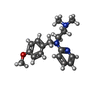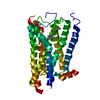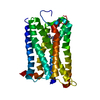+Search query
-Structure paper
| Title | Molecular mechanism of antihistamines recognition and regulation of the histamine H receptor. |
|---|---|
| Journal, issue, pages | Nat Commun, Vol. 15, Issue 1, Page 84, Year 2024 |
| Publish date | Jan 2, 2024 |
 Authors Authors | Dandan Wang / Qiong Guo / Zhangsong Wu / Ming Li / Binbin He / Yang Du / Kaiming Zhang / Yuyong Tao /  |
| PubMed Abstract | Histamine receptors are a group of G protein-coupled receptors (GPCRs) that play important roles in various physiological and pathophysiological conditions. Antihistamines that target the histamine H ...Histamine receptors are a group of G protein-coupled receptors (GPCRs) that play important roles in various physiological and pathophysiological conditions. Antihistamines that target the histamine H receptor (HR) have been widely used to relieve the symptoms of allergy and inflammation. Here, to uncover the details of the regulation of HR by the known second-generation antihistamines, thereby providing clues for the rational design of newer antihistamines, we determine the cryo-EM structure of HR in the apo form and bound to different antihistamines. In addition to the deep hydrophobic cavity, we identify a secondary ligand-binding site in HR, which potentially may support the introduction of new derivative groups to generate newer antihistamines. Furthermore, these structures show that antihistamines exert inverse regulation by utilizing a shared phenyl group that inserts into the deep cavity and block the movement of the toggle switch residue W428. Together, these results enrich our understanding of GPCR modulation and facilitate the structure-based design of novel antihistamines. |
 External links External links |  Nat Commun / Nat Commun /  PubMed:38167898 / PubMed:38167898 /  PubMed Central PubMed Central |
| Methods | EM (single particle) |
| Resolution | 3.0 - 3.5 Å |
| Structure data | EMDB-38074, PDB-8x5x: EMDB-38075, PDB-8x5y: EMDB-38078, PDB-8x63: EMDB-38079, PDB-8x64: |
| Chemicals |  ChemComp-XB7:  ChemComp-Y5E:  ChemComp-Y5R: |
| Source |
|
 Keywords Keywords | MEMBRANE PROTEIN / GPCR |
 Movie
Movie Controller
Controller Structure viewers
Structure viewers About Yorodumi Papers
About Yorodumi Papers











 homo sapiens (human)
homo sapiens (human)
